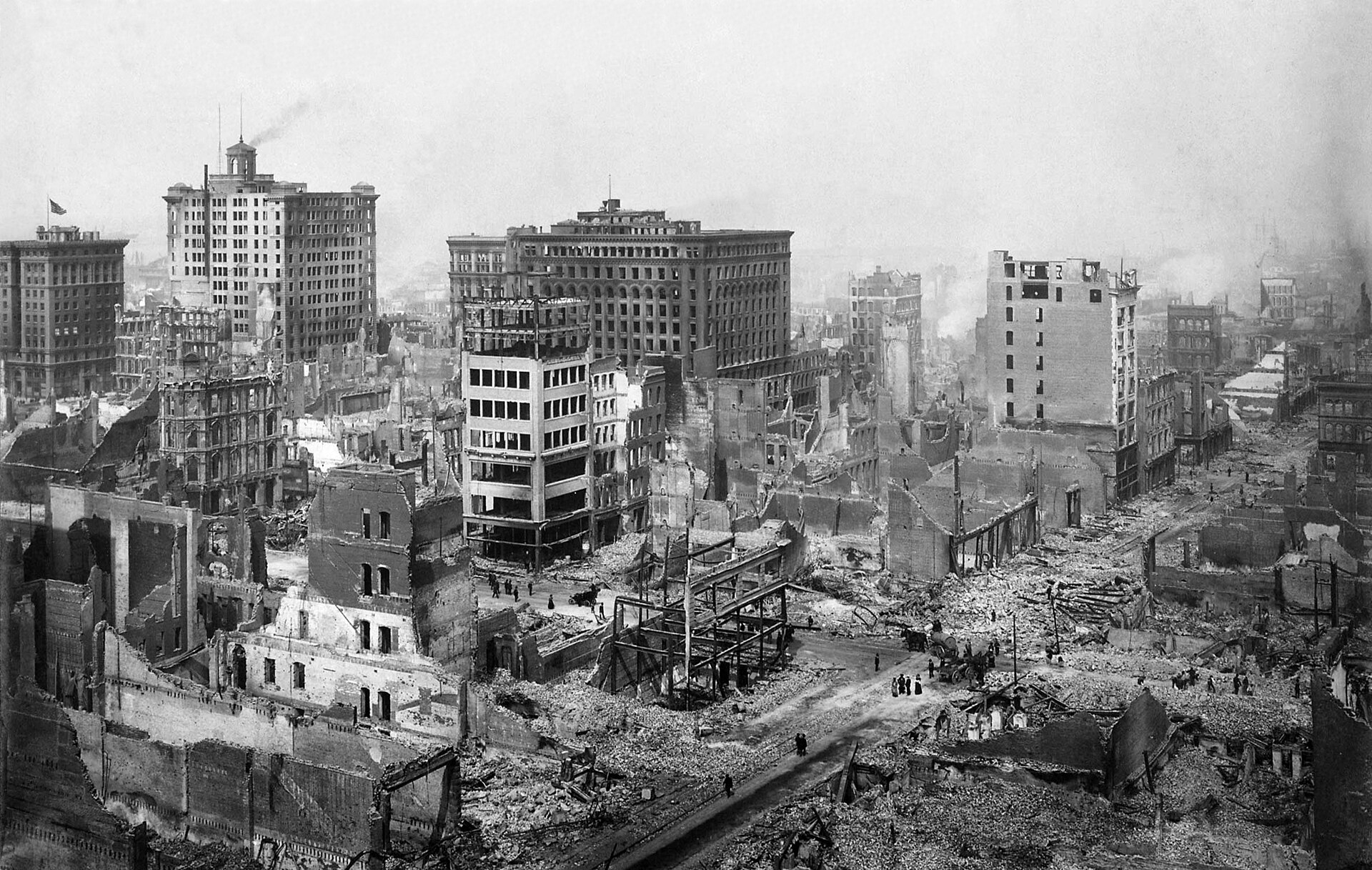Author Matthew J. Davenport’s new book The Longest Minute tells the riveting and tragic true story of the 1906 earthquake and fire in San Francisco. Read an excerpt below.
It was a few seconds past 5:12 a.m. on Wednesday, April 18, 1906. Jesse Cook, the veteran police sergeant who prided himself on knowing how things on his beat and in his city were going, found himself huddled in a doorway with strangers wondering when the shaking would finally end. Cook knew only that in the slow passing of those few crowded seconds, he had seen the ground open, buildings fall, and men die. Unable to see beyond the street corner or the moment, he had no grasp on the scope of disaster then unfolding.
By the time the shaking stopped, hundreds across the city were already dead, most killed while sleeping in their beds. Flimsy lodging houses of three, four, and five stories collapsed and sank into landfills. Beneath broken streets, iron water mains—like the one Sergeant Cook had hurdled—had cracked and shattered. Power and telephone lines were twisted and torn, cutting off communications and disabling alarms. It was the strongest earthquake even the oldest residents of the city had ever endured—still today one of the strongest in the recorded history of California—and for those who survived its long moments of violent jolting, the worst was yet to come.

Flames ignited in dozens of businesses and dwellings and spread like a brushfire through city block after city block of clustered, dry wooden structures. Survivors in the path of the spreading blazes fled their homes with what could fit into wagons or trunks or be carried to the open ground of parks or onto ferries to evacuate as individual fires grew into a firestorm. People pinned in ruins and rubble were doomed to asphyxiate from toxic smoke or incinerate in the flames. Firefighters responded everywhere they could, fighting against time as much as fire, digging to rescue at least a few trapped souls before flames overtook them. But in most places, with little to no pressure at hydrants, firemen could only pull last reserves of water from emergency cisterns or precious trickles from hydrants. With little water to stop it, and fed in places by onshore winds or by new blazes started with black powder or dynamite in the hands of amateur demolition crews, the firestorm devoured the city—block by block, business by business, home by home—without pause for three days and three nights.
News of the earthquake and fire traveled faster than news had ever traveled before—over telephone lines and telegraph wires and even through wireless signals. The nation and world read details of the earthquake within hours of it striking, and over the coming days, AP wires carried the latest on the slow destruction of San Francisco by fire. Newspapers in towns and cities nation-wide issued “Extra!” editions and evening issues with news of the spreading inferno, all bought by readers eager for updates. It was the first such event to be followed nationally in almost real time, giving it unprecedented attention and immediacy. And having struck in a city filled with professional photographers and in a time when cameras were cheaper and more widely available than ever before, it became the most-photographed disaster of its time. Vivid images of skyscrapers engulfed in flames and an entire city leveled to an apocalyptic ash heap of ruins—even motion pictures of the aftermath captured on hand-cranked cameras—were seen far and wide, adding life to sterile newsprint and closeness to a distant tragedy, capturing the attention and imagination of people coast-to-coast and making it America’s first truly national disaster.
When the last fire was extinguished, the smoke cleared to reveal a dystopian wasteland and laid bare the breadth of destruction and depth of loss. In many of San Francisco’s largest districts and neighborhoods, nearly every resident had lost their home, church, library, theater, grocery store, butcher shop, bakery, dry goods store, drugstore, and favorite restaurant and coffee shop. Most downtown employees lost their workplaces, and every South of Market child lost their school. Every inhabitant of Chinatown lost their home, and every merchant, their store. The city’s downtown banking and harbor districts (the current-day Financial District) were reduced to stripped skeletons and rubble, including all fifty of its banks. City Hall was shaken to a crumbled shell and had many of its vital records incinerated by the firestorm that had destroyed the city’s landmarks and largest homes and gutted its tallest buildings and grandest hotels. Seventy-five church sanctuaries were destroyed, including all three cathedrals and five of the seven synagogues. On one end of a city block, four lodging houses packed with tenants occupying more than one hundred rooms had collapsed and burned so quickly that only a handful of people escaped, and the ash of incinerated residents mixed with the ash of their flattened rooms, along with the dust of other wooden flats jammed into the same block—just one of more than five hundred blocks stripped, leveled, or vaporized.
Never had a major American city been so totally destroyed. But within days, newspaper coverage of the disaster shifted to optimistic stories of rebirth and rebuilding, part of a concerted effort by city leaders and business owners to persuade displaced residents to return and reassure potential developers that San Francisco was a safe bet for investment and growth. “GREAT BUILDINGS ARE TO RISE FROM ASHES” ran the headline of the Chronicle one week after the earthquake. Front-page stories highlighted “a spirit of unity” that had “arisen out of the fire” and would lead to “the making of a grander city.” Reporters insisted “the calamity should be spoken of as ‘the great fire’ and not ‘the great earthquake,’ ” and they began to refer to the disaster as “the great fire” to avoid a perception of San Francisco as earthquake-prone. And the Board of Supervisors fixed the total dead at the misleadingly low number of 478, while thousands were still unaccounted for and remains were still being found.
Rubble was cleared and homes were rebuilt and businesses reopened, and in the first few years that followed, the anniversary of the disaster served mostly as a benchmark for the progress of the city’s rebirth. “SAN FRANCISCO WILL CELEBRATE TODAY THE ACHIEVEMENTS OF ONE YEAR OF RECONSTRUCTION” read the April 18, 1907, headline of the Chronicle. “SAN FRANCISCO’S REBUILDING IS WONDER OF WORLD” declared the Examiner on April 18, 1908, and on the 1909 anniversary, the Call headlined “HOME AGAIN AFTER THREE YEARS.” In 1915, the city hosted the Panama–Pacific International Exposition, a world’s fair to acclaim the completion of the Panama Canal and showcase San Francisco’s nine-year recovery and celebrate “the rebuilding which has obliterated almost all traces of the disaster.”
In the decades that followed, the city’s skyline grew to surpass its former heights, and “1906” became a universal touchstone for all parts of the disaster—the earthquake, the fire, the injury and death, the loss of one’s home and pets and all material possessions. “1906” was a common answer by survivors to questions of what happened to their childhood home, their first job, their father’s store, the school they once attended, or how a loved one died. It became shorthand for the fate of a church’s first sanctuary or the elegant interior of a hotel, and the reason why, on many city streets, not a single house or restaurant or store or apartment building predates that year. “1906” came to be invoked by residents of all ages and races and classes as a unifying reminder of shared suffering and collective fortitude. “1906 Survivor” was employed as an honorific title for aging survivors who would appear at annual commemorations and share their memories, an exclusive club that dwindled each year until its last known member passed in 2016. And now in a time with the last survivor gone and no living connection to the city that was, “1906” has endured as San Francisco’s historical demarcation line between its current life and its former.
Today, as with the label itself, 1906 is reduced mostly to numbers, recited as quantifiable benchmarks to wedge the catastrophe into its assigned slot on the list of historical disasters ranked by scale. Research seismologists and geophysicists and geologists have studied the data for more than a century to tell us the science: the seismic event that struck the morning of April 18, 1906, was a tectonic earthquake that ruptured 296 miles of the San Andreas Fault with an estimated moment magnitude of 7.9. And thanks to archivists and librarians and genealogists and historians, many of whom painstakingly worked to correct a distorted historical record, the quantifiable loss suffered in San Francisco during the Great Earthquake and Fire is now also widely known: every home and business in more than twenty-eight thousand structures covering more than five hundred city blocks—nearly five square miles—was destroyed. Approximately a quarter million residents or more were made homeless, and it has been estimated that more than three thousand people were killed.
Copyright © 2023 by Matthew J. Davenport. All rights reserved.
 Matthew J. Davenport’s first book, First Over There, a finalist for the 2015 Guggenheim-Lehrman Prize in Military History, was acclaimed as “a brilliant work for every library” by Library Journal and was heralded by Pulitzer-Prize winning historian James McPherson as “military history at its best.” Davenport has been a contributing writer for the Wall Street Journal Book Review and salon.com and is a member of the Authors Guild. A native of Missouri and a former prosecutor, he practices law in North Carolina where he lives with his wife and two sons.
Matthew J. Davenport’s first book, First Over There, a finalist for the 2015 Guggenheim-Lehrman Prize in Military History, was acclaimed as “a brilliant work for every library” by Library Journal and was heralded by Pulitzer-Prize winning historian James McPherson as “military history at its best.” Davenport has been a contributing writer for the Wall Street Journal Book Review and salon.com and is a member of the Authors Guild. A native of Missouri and a former prosecutor, he practices law in North Carolina where he lives with his wife and two sons.
